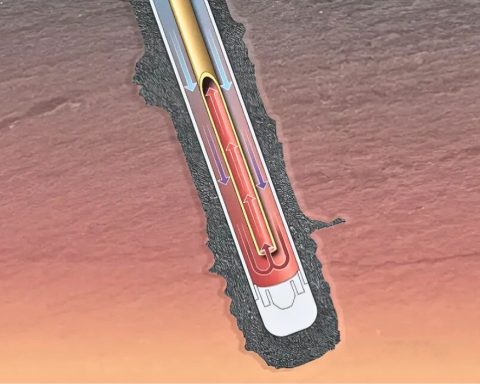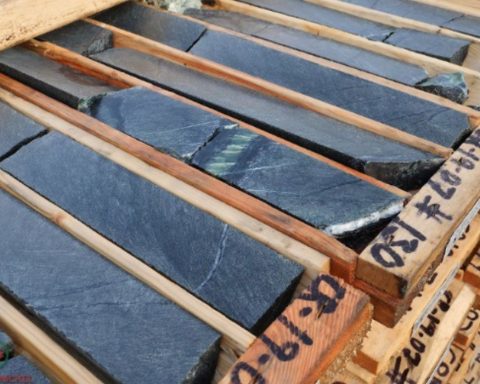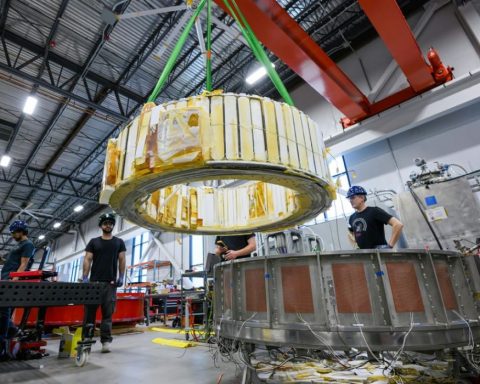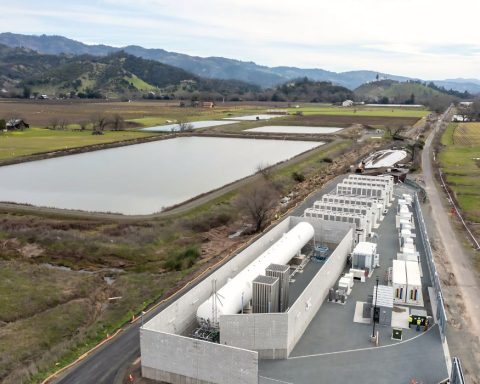The Prius Prime is Toyota’s first plug-in electric hybrid car for the mass market in the United States and a flag-bearer for the company’s future. In June, the Japanese automaker announced plans to have all-electric versions of every vehicle in its lineup and draw half of its sales from a mix of electrified vehicles by 2025. Building all those EVs introduces new design challenges for automakers. The batteries are by far the most expensive parts in an EV, so this places a premium on reducing the car’s overall weight; a lighter car means fewer batteries required to make it race down the highway and a lower sticker price. And so it’s notable that the Prius Prime’s rear hatch differs from those of standard Priuses in one important aspect: it’s made from carbon fibre.
Carbon fibre is a material perfectly suited to electric vehicles. Manufactured from long strands of carbon blended with plastic resin (think fibreglass, with carbon replacing the glass), it’s far stronger than steel – up to 10 times as strong – and much lighter. Plus it doesn’t corrode. Owing to these advantages, carbon fibre has been coveted by car makers since it was first introduced in the early 1980s. Because of its steep price, though, it has until recently been used primarily in racing cars and next-generation prototypes. (Carbon fibre costs as much as US$7 per pound wholesale, compared to about 40 cents per pound for steel or 80 cents for aluminum.) The explosive growth in electric vehicle sales, however, creates a unique and potentially enormous market for carbon fibre – especially if the manufacturing costs of the stuff can be slashed somehow.
And this is where Alberta’s oil sands come in. Alberta produces nearly three million barrels of bitumen from the oil sands each day – heavy oil in need of expensive and energy-intensive processing to be turned into transportation fuel. The industry faces an uncertain and perilous future as the high cost and large carbon footprint of its product becomes harder and harder to sell as demand for oil begins to level off and eventually decline, in part due to the rise of emissions-free technologies such as electric cars. Might there be a place for bitumen instead in the carbon-fibre frames of those vehicles?
This was the question Alberta Innovates, the Alberta government’s research arm, aimed to answer with its Bitumen Beyond Combustion program, launched three years ago to begin exploring new commercial uses for bitumen. The program’s research identified a range of potential new markets, including asphalt for paving and the production of vanadium, a metal present in relatively abundant quantities in bitumen and in increasing demand as a component in new battery technology. But nothing else so far has shown the “major mid- to long-term potential” that carbon fibre has. What’s more, its greatest weakness as a transport fuel – its heaviness, owing to the very large carbon molecules that comprise it – becomes an asset.
“Bitumen is a bigger molecule, and you are competing with lighter oils as transportation fuel,” John Zhou, vice president of clean energy at Alberta Innovates, explains. “You are always at a disadvantage. But when you are making big molecules like carbon fibre, that high carbon in the bitumen compared with other oil becomes a competitive advantage.”
To transform bitumen into the lighter crude oils that are refined into gasoline and transportation fuels, oil sands operations either add a lighter petroleum product called diluent to their bitumen to make it flow down a pipeline to a distant heavy oil refinery or use costly, energy-intensive upgrading facilities that “crack” the bitumen into smaller molecules, turning it into synthetic crude. In recent years, oil sands companies have been developing “partial upgrading” technology, which cracks off a smaller piece of the bitumen molecule and allows it to be shipped without diluent. One of the heavy carbon molecules cracked off the raw bitumen is called asphaltene, and it shows enormous promise as a feedstock for producing the long carbon fibres that go into the lightweight, ultra-strong carbon-fibre panels used in cars like the Toyota Prius Prime.

Asphaltenes make up around 15 to 18% of a typical barrel of bitumen. Produce 100 barrels of bitumen and send them through a partial upgrader, in other words, and you have 15 to 18 barrels of asphaltene on your hands. The world’s current supply of carbon fibre is about 100,000 tonnes per year, a total that oil sands operators could easily exceed with the widespread use of partial upgrading.
“The supply is not the issue,” Zhou says. The big question is whether carbon fibre produced from bitumen could cut carbon fibre costs to the point where the material made sense not just for a flagship Prius but for Honda Civics and Ford Fusions. “If you can reduce the cost of carbon fibre by 50% or more, you will have a chance to get into medium-priced vehicles. So you will open up a much greater market.”
It’s an enticing possibility, especially for an oil sands industry battered by low prices, fleeing investment capital and a barrage of criticism over its expanding greenhouse gas emissions and other environmental impacts. “It’s early days in looking at the potential for carbon fibre production from bitumen; however, we think there’s value in looking at different ways of optimizing our barrels – value in the traditional sense and in potential environmental benefits,” says Carrie Fanai, who is leading Suncor’s participation in the carbon fibre project at Alberta Innovates. With partial upgrading technology perhaps only three years away from commercial-scale operation, oil sands companies will soon have stronger motivation to find uses for the by-products of bitumen processing.
“When you are making big molecules like carbon fibre, that high carbon in the bitumen becomes a competitive advantage.”
–John Zhou, Alberta Innovates
The carbon fibre market, though, remains a young and volatile one, and that means any plans regarding its future role come freighted with caveats. Cecilia Gee, an analyst with Lux Research who tracks the carbon fibre market, explains that carbon fibre is at present a niche product, and many factors beyond the price and availability of the raw material, in the automotive market and beyond, will determine future demand. At present, the use of carbon fibre in EVs, for example, is limited by a lack of standardized production and supply chain certainty, and as much as 70% of the cost associated with using carbon fibre comes from the high price of manufacturing and installing components made from carbon fibre – not from the cost of the raw material the oil sands might one day supply. Meanwhile, plummeting battery prices are taking some of the pressure off EV manufacturers to pay a premium to reduce the weight of their vehicles. BMW, for example, recently announced it will no longer be using carbon fibre in some of its electric cars as it expands production.
“Is there an opportunity for the oil sands? Yes,” Gee says. “Are there a lot of unknowns about that future? Also yes. But if they have the opportunity to make things more circular, more green, why not?”
In any case, Alberta’s carbon fibre industry is a long way from supplying frames for hundreds of thousands of Civics; at present, it’s not even an industry. In the wake of the Bitumen Beyond Combustion program’s final report in January 2018, Alberta Innovates freed up $2 million in seed money for a handful of initiatives, one of which is a laboratory at the University of Alberta now working on developing an industrial process for converting bitumen-derived asphaltenes into carbon fibre. The early results have been so promising that Alberta Innovates has already connected the lab with industry heavyweights like BASF and Mitsubishi Chemical. A representative from SGL, a market leader in carbon fibre manufacturing, has paid multiple visits to the lab and has made plans to connect the researchers with similar projects at the Oak Ridge National Laboratory, the U.S. Department of Energy’s top energy research lab.
These are, to be sure, very early days. There remain many hurdles yet to clear. But presuming that partial upgrading expands at the rate Zhou and his colleagues in the oil sands hope it does and that the lab research on bitumen-derived carbon fibre continues apace, there could be viable commercial-scale carbon fibre production in Alberta by around 2030 – which just so happens to be around the time experts predict electric vehicle sales will roar into overdrive worldwide.
Zhou concedes that from an investor’s point of view, the project is very much in the high-risk, high-reward category. At a recent funding meeting with federal officials in Ottawa, he compared it to the $50 million the government recently invested in General Fusion, a Vancouver start-up working on nuclear fusion reactors. Still, the long timeline and uncertain payoff don’t worry Zhou much. “If in 10 to 15 years we can create a multi-billion-dollar business in Alberta, I will be very happy,” he says. Significantly less time, come to think of it, than it took bitumen production to go from Karl Clark’s lab at the University of Alberta to the first mine site north of Fort McMurray.
Chris Turner’s most recent book is The Patch: The People, Pipelines, and Politics of the Oil Sands.







